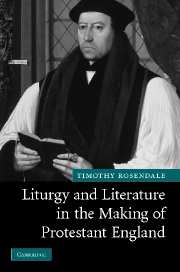1 - The Book of Common Prayer and national identity
Published online by Cambridge University Press: 22 September 2009
Summary
Where there has been a very godly order set forth by the authority of Parliament, for common prayer and administration of the sacraments to be used in the mother tongue within the Church of England, agreeable to the word of God and the primitive Church, very comfortable to all good people desiring to live in Christian conversation, and most profitable to the estate of this realm, upon the which the mercy, favour, and blessing of Almighty God is in no wise so readily and plenteously poured as by common prayers, due using of the sacraments, and often preaching of [the gospel, with the devotion of the hearers …
PERFORMING THE NATION
The Second Act of Uniformity's opening reference to the “godly order” suggests, in its multiple possibilities of meaning – is the “godly order” a liturgical form? a command? an ideal, stable socio-religious structure? – something important about liturgical form: it is, inherently and always, a form of order. It implicitly demands a highly regimented subordination of private to public (common prayer is, after all, that prayer which is shared by, or distributed to, or demanded of, all), and requires that individuals play closely and deliberately scripted roles within the larger structures it posits; it tells them what to say, and when to stand up, sit down, and kneel, and in those actions an entire ideological world is articulated, constructed, and perpetuated.
- Type
- Chapter
- Information
- Publisher: Cambridge University PressPrint publication year: 2007



